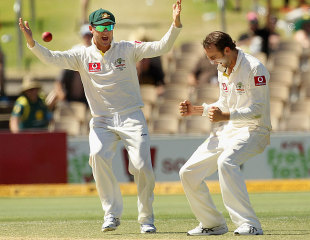
|
|||
|
Related Links
Review 2011 : 'We need a deep point. What if he gets four?'
Players/Officials:
Michael Clarke
Series/Tournaments:
Australia tour of West Indies
Teams:
Australia
|
|||
Captains: follow Clarke's lead
In the long run, captains who aim to win and set fields that will get them wickets are the ones who will succeed and last
April 22, 2012
Michael Clarke
is quickly establishing a well-deserved reputation for brave and
aggressive captaincy. His entertaining approach is based on one premise:
trying to win the match from the opening delivery. This should be the
aim of all international captains, but sadly it isn't.
In every era there are Test captains who prefer to attain a position of
safety before they go all out for victory. These captains are frightened
stiff of the Michael Clarkes, who make it obvious they are not
interested in a draw. At least 50% of international captains consider a
draw to be a good result and when that option is removed they easily
panic.
The first thing a captain like Clarke understands is that he will lose
some matches in constantly striving for victory. Once that premise is
accepted the captain has reached the stage where he hates to lose but
doesn't fear it. There's a huge difference: the latter is a positive
state where the captain will do everything in his power to win; the
former a mindset where the captain sets out not to lose.
An important indicator of a captain's thinking is his field placings. A
positive captain will always make the opposing batsmen feel their very
existence is threatened. Through his field placings he allows his
bowlers to turn at the top of their mark and see where a wicket (other
than bowled, lbw or through the batsman's stupidity) can be claimed.
A bowler operating to a purely containing field is like Zorro without
his sword; he's not very threatening. There has been plenty of
discussion on whether the shorter forms of the game will adversely
affect batting techniques and turn bowlers into cannon fodder. What the
50- and 20-over matches have actually had a marked influence on is field
placings.
Whereas the No. 1 priority, by a wide margin, used to be taking wickets,
followed by saving singles, and then, way off in the distance, stopping
boundaries, in the mind of the modern captain the last one has assumed
far too much importance.
The almost robotic use in Test matches of a deep cover point and a
backward square leg on the boundary, regardless of whether the ball is
being played in that direction, borders on mindless captaincy. When a
fieldsman is unemployed for half an hour but the captain still retains
him in that position, you have to wonder: who appointed this captain?
The change in attitude to field placings is perfectly summed up with some typical Caribbean humour and common sense.
Former West Indies fast bowler Herman Griffith was captaining a Barbados
club side in the 1930s once, and called on his debutant offspinner to
have a trundle. "Where do you want the field?" asked Griffith politely.
"I'd like a deep-backward square leg, a midwicket on the boundary and a long-on and long-off," replied the youngster.
"Give me the ball," growled Griffith.
Not unreasonably, the young man asked, "Why?"
"You intending to bowl shite," came the forthright answer.
Nowadays, most bowlers would be horrified if the captain didn't
automatically give him a number of protective fielders in the deep.
Clarke is not such a captain.
Sadly, his latest gambit - a challenging declaration at the Queen's Park Oval,
which was answered with equal bravado by Darren Sammy, failed because
of inclement weather. Nevertheless, it's to be hoped their positive
endeavours have acted as a sharp reminder to the administrators.
In Test cricket the captain is allowed free rein. We've seen in the case
of Clarke and Sammy what's possible when two captains use a bit of
imagination and have a desire to produce a result. It's impossible to
legislate for captaincy imagination. In the 50-over game, which is
highly regulated through a variety of Powerplays, and bowling and field
restrictions, there is less real captaincy involved.
Wherever possible, the captaincy should be left to the skippers, and
those with imagination will prosper. Hopefully those who lack
inspiration and the nerve to face a challenge will be quickly replaced
by the selectors.
No comments:
Post a Comment